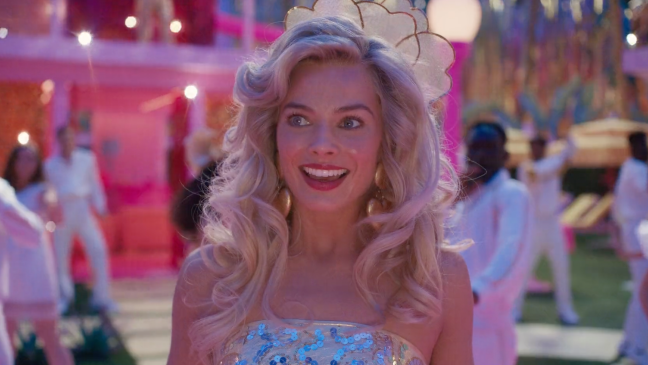Rarely in recent years has so much public attention been riveted on three films opening over a single two-week period. Just as “Mission: Impossible — Dead Reckoning Part One” (Paramount) has arrived, and just ahead of the July 21 openings of “Barbie” (Warner Bros. Discovery) and “Oppenheimer” (Universal), hopes for three distinct films changing the trajectory for the summer are sky-high.
Ahead of the initial reports on “Mission: Impossible” results from pre-Wednesday previews, here’s a film-by-film analysis of the opportunities and challenges for each film, as well as their combined potential for theaters.
Two things to note ahead: The pre-marketing cost on this latest sequel has been reported as $290 million, triple both of the previous two films in the “Mission: Impossible” franchise. And you might have noticed the marketing? Not cheap either.
Then, there are the expectations. Anything less than the biggest film of the summer (“Spider-Man: Across the Spider-Verse” is heading to close to $400 million) or even the year (“The Super Mario Bros. Movie” $574 million) might seem disappointing.
That’s unfair and unrealistic. That potential certainly exists, but so do impediments.
The consistent appeal of this franchise since 1996 (as well as its consistent quality) is evident. The first two, ranked #3 for their years, were the high mark. “Fallout,” the most recent, was #8 for 2018, with an adjusted domestic gross of around $250 million.

“Mission: Impossible — Fallout”©Paramount/Courtesy Everett Collection / Everett Collection
This summer has consistently shown multiple franchise titles falling short of high-end expectations (“Indiana Jones and the Dial of Destiny” being the nadir). “Fast X” was a disappointment. Both “Dial of Destiny” and “Fast X” will end up around $150 million, which is not acceptable for $300 million or higher-cost titles. But could lesser sequel resistance be a factor here?
Though past films have overcome this, “Mission: Impossible” is the first half of a two-part story. That could impact reactions, thanks to an ending that, by all accounts, only whets the appetite for more.
“Mission: Impossible” also faces the issue of limited playtime in premium theaters, as well as second-weekend competition from both “Barbie” and “Oppenheimer.” A handful of films this summer (“Spider-Verse,” “The Little Mermaid,” “Elemental”) have sustained strong holds, but the norm this year has been quick falloffs.
On the plus side, this is getting initially strong reviews (81 Metacritic score as of now, second best to 86 for “Fallout”) and comes off the goodwill Cruise created with last summer’s smash hit “Top Gun: Maverick.” That alone should help elevate it.
Domestic returns are important, but any response to the film’s grosses should be more on the international side, both because of precedent (the previous two films’ take came from less than 30 percent domestic) but also because foreign share has been cratering recently for some high-budget films (“Dial of Destiny” and “Little Mermaid” were both around 50 percent). Pre-COVID, “normal” was a film like this to do two-thirds or more business overseas.
The good news is “Fast X” was 79 percent. The “Mission: Impossible” films overlap with the “Fast” and James Bond films as established, high-end action series known for spectacular stunts and worldwide settings. “No Time to Die,” similarly, was 79 percent foreign. That means domestic response will be less critical to overall success.
Paramount is pushing all the buttons to maximize the gross. A Wednesday opening, plus three different sets of previews that started more limited (Sunday, Monday, and Tuesday) will produce a higher gross than just the normal Friday start. And the hope is that initial positive response make the weekend bigger.

Margot Robbie as “Barbie”Warner Bros.
These are two significant non-franchise titles in the heart of the summer, both costing around $100 million, both from previously acclaimed directors, with both hoping to receive both critical and popular positive response to propel them beyond the pre-release appeal the films already have.
The awareness for “Barbie” has been sky-high since production was announced. That sort of interest is tricky to acclaim. The marketing has not faltered through its one-showing premiere last Sunday.
Like “Oppenheimer,” it faces challenges. It’s not what a four-quadrant movie (its appeal initially is skewing more female). It’s a comedy, with a tricky path to find the right balance.
It also has in Greta Gerwig a director whose “Lady Bird” and “Little Women” both surpassed expectations, and Margot Robbie and Ryan Gosling as leads, and of course familiarity with the iconic dolls. And its originality might actually be an asset as audiences get more resistant to retreads.
“Oppenheimer” with Christopher Nolan directing (of course, a huge part of its draw) has likewise been in the spotlight since announced. As a biopic about a scientist, partially in black and white, 180 minutes, it’s not normal summer wide-release fare.
Nolan has smartly positioned the film as a visual experience. His previous films have emphasized premium formats, and the curiosity about how the spectacular power of atomic explosions are conveyed in state-of-the-art technology is high with this one.

“Dunkirk”Warner Bros/Kobal/Shutterstock
His previous World War II-set “Dunkirk,” also released in July, was a success with adjusted grosses of around $200 million domestic/$600 million worldwide. It had the advantage of military action (a draw for older male audiences who rarely go to theaters). The appeal of the subject matter is less clear here. Apart from what promises to be a sensory experience, Nolan’s reputation and the expectation of top-level reviews add interest.
The two films will follow different paths.
“Barbie” might open to double “Oppenheimer” (perhaps $100 million to $50 million), but if those are the figures, that’s parallel success. “Barbie” should have a heavier domestic share, while Nolan has generally approached two-thirds foreign. “Oppenheimer” is handicapped by its length, combined with strong interest in seeing it on premium screens. That will limit seating initially (similar to “Avatar: The Way of Water”), but assuming it sustains interest, it could see a strong multiple. (“Dunkirk” got to $188 million from a $50 million opening weekend, less burdened by initial limitations and competition.)
Theaters need money into the till and fast. The range of suggested expectations ($300 million domestic for “Mission: Impossible,” $200 million for the other two) should be enough to improve the current situation. Last July saw a domestic gross of $1.134 billion. At those levels, combined with other films, $1.2 billion (best month since 2019) is doable.
Both “Mission: Impossible” and “Barbie” have the strongest upsides during the months above these levels (“Oppenheimer,” again, perhaps more over a longer period). If either or both overperform and push the total higher, it would be a clear win for theaters.
And over-performance by “Mission: Impossible” would provide relief that franchise fatigue can be overcome with a smart production. For “Barbie” and “Oppenheimer,” success would encourage more non-franchise top-end pictures, as well as deeper trust in proven creative directors like Nolan and Gerwig.
But the risk that one or more of them does less than expected also exists. Four years into the COVID-impact experience, it’s not getting any easier.
Ahead of the initial reports on “Mission: Impossible” results from pre-Wednesday previews, here’s a film-by-film analysis of the opportunities and challenges for each film, as well as their combined potential for theaters.
“Mission: Impossible — Dead Reckoning Part One”
Two things to note ahead: The pre-marketing cost on this latest sequel has been reported as $290 million, triple both of the previous two films in the “Mission: Impossible” franchise. And you might have noticed the marketing? Not cheap either.
Then, there are the expectations. Anything less than the biggest film of the summer (“Spider-Man: Across the Spider-Verse” is heading to close to $400 million) or even the year (“The Super Mario Bros. Movie” $574 million) might seem disappointing.
That’s unfair and unrealistic. That potential certainly exists, but so do impediments.
The consistent appeal of this franchise since 1996 (as well as its consistent quality) is evident. The first two, ranked #3 for their years, were the high mark. “Fallout,” the most recent, was #8 for 2018, with an adjusted domestic gross of around $250 million.

“Mission: Impossible — Fallout”©Paramount/Courtesy Everett Collection / Everett Collection
This summer has consistently shown multiple franchise titles falling short of high-end expectations (“Indiana Jones and the Dial of Destiny” being the nadir). “Fast X” was a disappointment. Both “Dial of Destiny” and “Fast X” will end up around $150 million, which is not acceptable for $300 million or higher-cost titles. But could lesser sequel resistance be a factor here?
Though past films have overcome this, “Mission: Impossible” is the first half of a two-part story. That could impact reactions, thanks to an ending that, by all accounts, only whets the appetite for more.
“Mission: Impossible” also faces the issue of limited playtime in premium theaters, as well as second-weekend competition from both “Barbie” and “Oppenheimer.” A handful of films this summer (“Spider-Verse,” “The Little Mermaid,” “Elemental”) have sustained strong holds, but the norm this year has been quick falloffs.
On the plus side, this is getting initially strong reviews (81 Metacritic score as of now, second best to 86 for “Fallout”) and comes off the goodwill Cruise created with last summer’s smash hit “Top Gun: Maverick.” That alone should help elevate it.
Domestic returns are important, but any response to the film’s grosses should be more on the international side, both because of precedent (the previous two films’ take came from less than 30 percent domestic) but also because foreign share has been cratering recently for some high-budget films (“Dial of Destiny” and “Little Mermaid” were both around 50 percent). Pre-COVID, “normal” was a film like this to do two-thirds or more business overseas.
The good news is “Fast X” was 79 percent. The “Mission: Impossible” films overlap with the “Fast” and James Bond films as established, high-end action series known for spectacular stunts and worldwide settings. “No Time to Die,” similarly, was 79 percent foreign. That means domestic response will be less critical to overall success.
Paramount is pushing all the buttons to maximize the gross. A Wednesday opening, plus three different sets of previews that started more limited (Sunday, Monday, and Tuesday) will produce a higher gross than just the normal Friday start. And the hope is that initial positive response make the weekend bigger.

Margot Robbie as “Barbie”Warner Bros.
“Barbie” and “Oppenheimer”
These are two significant non-franchise titles in the heart of the summer, both costing around $100 million, both from previously acclaimed directors, with both hoping to receive both critical and popular positive response to propel them beyond the pre-release appeal the films already have.
The awareness for “Barbie” has been sky-high since production was announced. That sort of interest is tricky to acclaim. The marketing has not faltered through its one-showing premiere last Sunday.
Like “Oppenheimer,” it faces challenges. It’s not what a four-quadrant movie (its appeal initially is skewing more female). It’s a comedy, with a tricky path to find the right balance.
It also has in Greta Gerwig a director whose “Lady Bird” and “Little Women” both surpassed expectations, and Margot Robbie and Ryan Gosling as leads, and of course familiarity with the iconic dolls. And its originality might actually be an asset as audiences get more resistant to retreads.
“Oppenheimer” with Christopher Nolan directing (of course, a huge part of its draw) has likewise been in the spotlight since announced. As a biopic about a scientist, partially in black and white, 180 minutes, it’s not normal summer wide-release fare.
Nolan has smartly positioned the film as a visual experience. His previous films have emphasized premium formats, and the curiosity about how the spectacular power of atomic explosions are conveyed in state-of-the-art technology is high with this one.

“Dunkirk”Warner Bros/Kobal/Shutterstock
His previous World War II-set “Dunkirk,” also released in July, was a success with adjusted grosses of around $200 million domestic/$600 million worldwide. It had the advantage of military action (a draw for older male audiences who rarely go to theaters). The appeal of the subject matter is less clear here. Apart from what promises to be a sensory experience, Nolan’s reputation and the expectation of top-level reviews add interest.
The two films will follow different paths.
“Barbie” might open to double “Oppenheimer” (perhaps $100 million to $50 million), but if those are the figures, that’s parallel success. “Barbie” should have a heavier domestic share, while Nolan has generally approached two-thirds foreign. “Oppenheimer” is handicapped by its length, combined with strong interest in seeing it on premium screens. That will limit seating initially (similar to “Avatar: The Way of Water”), but assuming it sustains interest, it could see a strong multiple. (“Dunkirk” got to $188 million from a $50 million opening weekend, less burdened by initial limitations and competition.)
The Stakes for the Summer and Beyond
Theaters need money into the till and fast. The range of suggested expectations ($300 million domestic for “Mission: Impossible,” $200 million for the other two) should be enough to improve the current situation. Last July saw a domestic gross of $1.134 billion. At those levels, combined with other films, $1.2 billion (best month since 2019) is doable.
Both “Mission: Impossible” and “Barbie” have the strongest upsides during the months above these levels (“Oppenheimer,” again, perhaps more over a longer period). If either or both overperform and push the total higher, it would be a clear win for theaters.
And over-performance by “Mission: Impossible” would provide relief that franchise fatigue can be overcome with a smart production. For “Barbie” and “Oppenheimer,” success would encourage more non-franchise top-end pictures, as well as deeper trust in proven creative directors like Nolan and Gerwig.
But the risk that one or more of them does less than expected also exists. Four years into the COVID-impact experience, it’s not getting any easier.

